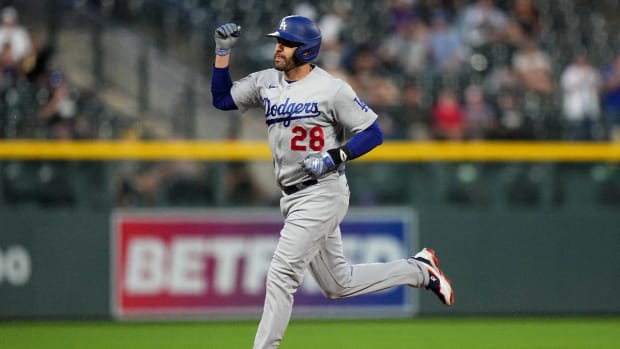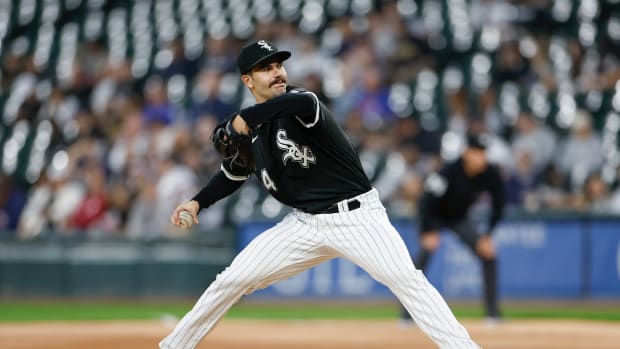What will this Penny be worth to the Red Sox?
Brad Penny has reportedly agreed to a one-year deal with the Boston Red Sox with a base salary of $5 million and incentives that increase the value of the deal to $8 million. That might seem like a weak answer to the $243.5 million the Yankees lavished on CC Sabathia and A.J. Burnett, but it's important to remember that it's not the Red Sox who are trying to keep up with the Yankees, but the other way around. The Red Sox have finished ahead of the Yankees in the American League East standings in each of the last two seasons. The last time that happened was 1990 and '91, when the Yankees were among the worst teams in baseball.
A primary reason for that recent reversal of fortune has been the performance of the two teams' starting rotations. Over the past two seasons the Red Sox's starters posted a 4.12 ERA and averaged 6.04 innings per start while the Yankee starters averaged just 5.62 innings per start with a 4.58 ERA. The 30-year-old Penny is merely insurance for a Boston pitching staff that already stacks up well against its rival's reloaded rotation.
Consider the similarities between the two starting staffs now that Sabathia and Burnett have joined the Evil Empire. Both are led by young left-handed aces (Sabathia and Jon Lester). Even before Boston signed Penny, both featured overrated and injury-plagued former Florida Marlins (Burnett and Josh Beckett). Both include foreign imports in their twenties who succeed despite sketchy peripherals (Chien-Ming Wang and Daisuke Matsuzaka). Both are also hoping for big seasons from one of the game's top prospects (Joba Chamberlain and Clay Buchholz). And, should the Yankees eventually re-sign Andy Pettitte, both rotations will be rounded out by reliable veterans whose tenure with their respective teams dates back to 1995 (Pettitte and Tim Wakefield).
The Yankees have the advantage with Sabathia, who is arguably the best pitcher in baseball, while Lester is still working to establish himself, and Chamberlain, who has had more big-league success than Buchholz despite the latter's no-hitter. The Sox have the advantage with Beckett, who is better than Burnett when healthy and three years younger, and Wakefield until the Yankees actually get Pettitte under contract. Wang and Matsuzaka are something of a draw, though Wang's ability to survive his low strikeout rates by inducing ground balls is significantly more efficient and seems more sustainable than Matsuzaka's ability to finesse a lineup by walking the hitters he doesn't want to challenge. Penny has the potential to tip that balance in Boston's favor as a replacement for the fledgling Buchholz or the aging Wakefield (though 42 is hardly old for a pure knuckleballer), but there are significant concerns about Penny's ability to return to the form that made him an All-Star in 2006 and 2007.
Like most of his Florida rotation mates from the early part of the decade (including Burnett, Beckett and the Yankees' and Red Sox's twin free-agent disasters of 2005, Carl Pavano and Matt Clement), Penny has been plagued by injuries throughout his career. He strained his pitching shoulder in 2000, hit the DL with biceps injuries in '02 and '04, had his '05 season ended early by forearm tightness, and had shoulder and back problems in '06. Concerns about his conditioning (he's listed at 6-foot-4, 260 pounds) and pitching shoulder have followed him for years. An MRI in 2003 showed fraying of his rotator cuff, but he has never had surgery on the joint, preferring instead to rehabilitate it with rest and strengthening exercises. It was pain in that shoulder (diagnosed as merely tendonitis and inflammation) that ruined Penny's 2008 season, pushing him to the DL with a 5.88 ERA in mid-June and limiting him to four appearances, only two of them starts, over the remainder of the year.
Given that history, Penny looks less like a guaranteed part of Boston's rotation than their 2009 answer to Bartolo Colon. Indeed, Penny's '08 season bore a striking resemblance to Colon's '07:
Colon2007: 6-8, 6.34 ERA, 18 GSPenny 2008: 6-9, 6.27 ERA, 17 GS
The difference between Colon and Penny is that, in addition to being four years older when he signed with the Sox than Penny is now, Colon had two poor, injury-plagued seasons leading up to his Sox contract (2006: 1-5, 5.11 ERA, 10 GS), while Penny was among the best starters in the National League in 2007 (16-4, 3.03, 33 GS), finishing third in the Cy Young voting. That's why Colon signed with the Red Sox as a non-roster invitee on a minor league deal, while Penny has received a major league deal worth up to $8 million (though it's worth noting that the maximum value of Penny's new deal is less than the $9.25 million option that the Dodgers declined last month).
An interesting comparison can also be made between Penny and newly-inked Yankee and fellow ex-Marlin Burnett. Over the past three seasons Penny posted a 38-22 record and a 4.16 ERA over 83 starts and three relief appearances, made two All-Star teams and finished third in the 2007 NL Cy Young voting, while Burnett, who is nearly a year older, went 38-26 with a 3.94 ERA in 81 starts and one relief appearance and has never appeared on an All-Star team or received a Cy Young vote. Yet Burnett landed a five-year deal worth $82.5 million from the Yankees while the maximum value of Penny's deal is less than half of what Burnett will earn in 2009 alone.
Certainly the sharp difference in their walk year performances -- Burnett stayed healthy all season and won 18 games -- played a large part in that discrepancy (as did the fact that the Yankees wildly overpaid for Burnett), but it's also worth noting that Burnett's performance over those three seasons, despite some fluctuations in playing time, largely held steady as he averaged 2.75 K/BB.
Penny, on the other hand, saw his strikeout rate drop by roughly one punchout per nine innings in each of the last two seasons and has seen his walk rate increase in each of the last three, sending his K/BB rate nosediving from 2.98 in 2005 to a slightly-below-league-average 1.85 in his near-Cy Young season of '07 and a miserable 1.21 in his injury-plagued '08. Burnett also posted those numbers in the AL East, pitching regularly against the Yankees and Red Sox, while Penny was safely tucked away in the NL West. Taking Penny's declining performance and bum shoulder out of Dodger Stadium and the NL West and moving it to Fenway Park in the AL East is not a recipe for success, as evidenced by Penny's 5.08 career ERA in interleague play. Fortunately for the Red Sox, if things go according to plan they don't need Penny to be much more than a spot starter.




































